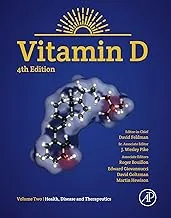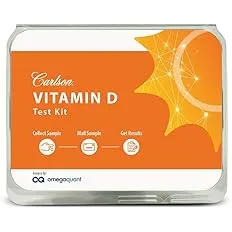Vitamin D: Benefits, Sources, and Daily Needs
Vitamin D: Benefits, Sources, and Daily Needs deficiency is a common vitamin deficiency that causes issues with your bones and muscles. It most commonly affects people over the age of 65 and people who have darker skin. It’s preventable and treatable.
Getting enough D helps the growth and development of bones and teeth. It may also provide improved resistance to certain diseases.
Vitamin D is a fat-soluble vitamin in a family of compounds that includes vitamins D1, D2, and D3.

Vitamin D: Volume 2: Health, Disease and Therapeutics
Vitamin D: Volume 2: Health, Disease and Therapeutics, Fourth Edition, authoritatively covers the evidence for new roles for vitamin D, ranging from cardiovascular disease, to cancer, diabetes, inflammatory bowel disease, multiple sclerosis and renal disease.
Offers a comprehensive reference, ranging from basic bone biology, to biochemistry, to the clinical diagnostic and management implications of vitamin D
Your body produces vitamin D naturally when it’s directly exposed to sunlight. You can also get vitamin D from certain foods and supplements to ensure adequate levels of the vitamin in your blood.
Vitamin D has several important functions. Perhaps the most vital are regulating the absorption of calcium and phosphorus and facilitating healthy immune system function.
Getting enough vitamin D is important for the typical growth and development of bones and teeth and for improving resistance to certain diseases.
Here is more information about the benefits of vitamin D, its downsides, how much you need, and foods with vitamin D.
What is vitamin D deficiency?
D deficiency means you don’t have enough vitamin D in your body. It primarily causes issues with your bones and muscles.
Vitamin D is an essential vitamin that your body uses for normal bone development and maintenance. D also plays a role in your nervous system, musculoskeletal system and immune system.

Carlson – Vitamin D Test Kit, at-Home D3 Test, Test Your Levels, 1 Test Kit.
- Collect Sample: A simple finger prick test will draw a few drops of blood.
- Mail Sample: The drop is mailed to OmegaQuant, where vitamin D status will be assessed.
You can get vitamin D in a variety of ways, including:
- Sun exposure on your skin (however, people with darker skin and older people may not get enough vitamin D through sunlight. Your geographical location may also prevent adequate vitamin D exposure through sunlight).
- Through the food you eat.
- Through nutritional supplements.
Why is vitamin D so important?
Vitamin D: Benefits, Sources, and Daily Needs is one of many vitamins your body needs to stay healthy. It plays a crucial role in maintaining the balance of calcium in your blood and bones and in building and maintaining bones.

More specifically, you need vitamin D so your body can use calcium and phosphorus to build bones and support healthy tissues.
With chronic and/or severe vitamin D deficiency, a decline in calcium and phosphorus absorption by your intestines leads to hypocalcemia (low calcium levels in your blood). This leads to secondary hyperparathyroidism (overactive parathyroid glands attempting to keep blood calcium levels normal).
Both hypocalcemia and hyperparathyroidism, if severe, can cause symptoms, including muscle weakness and cramps, fatigue and depression.
To try to balance calcium levels in your blood (via secondary hyperparathyroidism), your body takes calcium from your bones, which leads to accelerated bone demineralization (when a bone breaks down faster than it can reform).
This can further result in osteomalacia (soft bones) in adults and rickets in children.
Osteomalacia and osteoporosis put you at an increased risk for bone fractures. Rickets is the same as osteomalacia, but it only affects children. Since a child’s bones are still growing, demineralization causes bowed or bent bones.
Healthy bones
Vitamin D promotes calcium absorption and helps maintain adequate levels of calcium and phosphorus in the blood, which is necessary for healthy bones and teeth.
Vitamin D deficiency in children can cause rickets, leading to a bowlegged appearance due to the softening of the bones, and dental problems, such as teeth not forming as they should.
Similarly, in adults, vitamin D deficiency can manifest as osteomalacia, or softening of the bones. Long-term vitamin D deficiency can also lead to osteoporosis, or low bone density, which increases the risk of fractures.
HealthInsight’s : Medical information and health/Fitness advice you can trust
Vitamin D deficiency
Although the body can create vitamin D from sunlight, some people develop deficiencies. Factors that can influence this include:
- Lack of sun exposure: People who live in northern climates or areas of high pollution.
- may not get as much vitamin D as others. Those who work night shifts or do not go outside can also develop a deficiency.
- Skin color: Pigmentation in the skin reduces the body’s ability to absorb ultraviolet B (UVB) rays. Those with darker skin tones synthesize less vitamin D from sunlight than people with lighter skin.
- Age: The skin’s ability to synthesize vitamin D decreases with age. Older adults may also spend more time indoors.
- Breastfeeding: Babies cannot get enough vitamin D from breast milk on its own. The American Academy of Pediatrics recommends that exclusively and partially breastfed infants receive 400 international units (IU)
- Trusted Source
- per day of oral vitamin D until they are weaned. After weaning, they should get at least 1,000 mL/day vitamin D-fortified formula or whole milk. Children getting less than this, or who caregivers did not breastfeed, should take 400 IU vitamin D supplements.
- Body weight: High levels of fat in the body can limit its ability to absorb vitamin D from the skin.
- Certain medical conditions: Vitamin D is fat soluble, meaning intake is dependent on the gut absorbing dietary fats. Conditions that limit fat absorption can decrease vitamin D intake from the diet.
- Gastric bypass surgery: This surgery bypasses a part of the upper intestine that absorbs large amounts of vitamin D. This bypass can cause a deficiency.
Vitamin D in infants and children
Infancy and childhood is a period of rapid growth bone growth. Due to this, it is essential for infants to get adequate amounts of vitamin D.
Chronic vitamin D deficiency can cause rickets, which is a softening of bone tissues that can lead to the malformation of bones and joints.
Vitamin D deficiency also has links to high blood pressure in children. A 2018 study found a possible connection between low vitamin D levels and arterial wall stiffness.
The American Academy of Allergy Asthma and Immunology (AAAAI) suggests a connection between low vitamin D exposure and an increased risk of allergic sensitization.
Children who live closer to the equator, where light levels are higher, have lower rates of admission to the hospital for allergies and fewer prescriptions for epinephrine auto-injectors, or EpiPens. They are also less likely to have a peanut allergy.
1. Vitamin D may fight disease
In addition to its primary benefits, research suggests that vitamin D may also play a role in:
- Reducing the risk of multiple sclerosis (MS): A of population-based studies found that low levels of vitamin D are linked with an increased risk of MS.
- Decreasing the chance of heart disease: Low vitamin D levels have been linked to increased risk of heart diseases such as hypertension, heart failure, and stroke. However, it’s unclear
- whether vitamin D deficiency contributes to heart disease or indicates poor health when you have a chronic condition.
- Reducing the likelihood of severe illnesses: Although studies are mixed, vitamin D may make severe flu and COVID-19 infections less likely. A recent review found that low vitamin D levels contribute to acute respiratory distress syndrome.
- Supporting immune health: People who do not have adequate vitamin D levels might be at increased risk of infections and autoimmune diseases, such as rheumatoid arthritis, type 1 diabetes, and inflammatory bowel disease.
2. May regulate mood and reduce depression
Research has shown that vitamin D might play an important role in regulating mood and decreasing the risk of depression.
A review of 7,534 people found that those experiencing negative emotions who received vitamin D supplements noticed an improvement in symptoms. Vitamin D supplementation may help people with depression who also have a vitamin D deficiency. Another study identified low vitamin D levels as a risk factor for more severe fibromyalgia symptoms, anxiety, and depression.
3. May support weight loss
People with higher body weights have a greater chance of low vitamin D levels, and some studies suggest there may be a link between vitamin D and obesity, though more research is needed to verify this.
In an older study, people taking daily calcium and vitamin D supplements lost more weight than subjects taking a placebo supplement. The researchers suggest that the extra calcium and vitamin D may have had an appetite-suppressing effect.
Current research doesn’t support the idea that vitamin D causes weight loss, but there appears to be a relationship between vitamin D and weight.
Risks of getting too much vitamin D
If you take excessive amounts of vitamin D supplements, you may get too much of it. However, this is unlikely to happen through diet or sun exposure because your body regulates the amount of vitamin D produced through sun exposure.
Vitamin D toxicity can lead to an in your blood calcium levels. This can result in a variety of health issues, such as:
- frequent urination
- apathy
- vomiting
- abdominal pain
- dehydration
- confusion
- increased thirst
What food is highest in vitamin D?
Some foods contain vitamin D naturally, and others are fortified with it. You can find vitamin D in the following foods:
- salmon
- sardines
- herring
- canned tuna
- cod liver oil
- beef liver
- egg yolk
- regular mushrooms and those treated with ultraviolet light
- milk (fortified)
- certain cereals and oatmeals (fortified)
- yogurt (fortified)
- orange juice (fortified)
It can be hard to get enough vitamin D each day through sun exposure and food alone, so taking vitamin D supplements could help.






